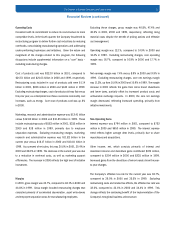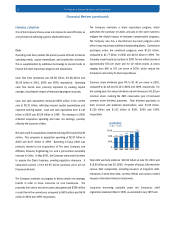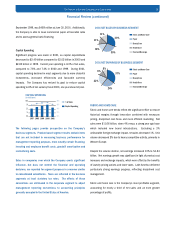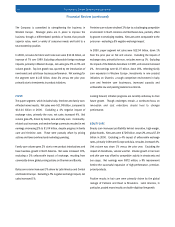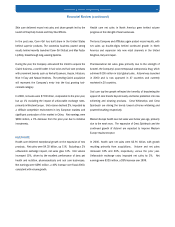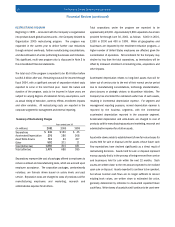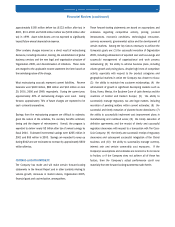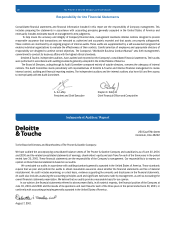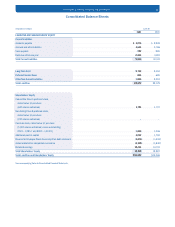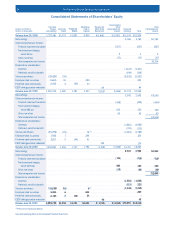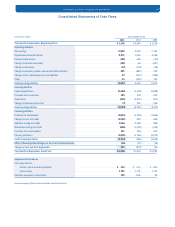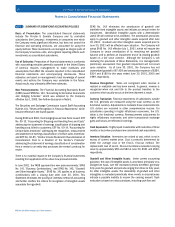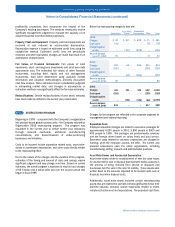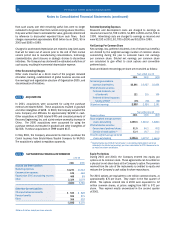Proctor and Gamble 2001 Annual Report Download - page 20
Download and view the complete annual report
Please find page 20 of the 2001 Proctor and Gamble annual report below. You can navigate through the pages in the report by either clicking on the pages listed below, or by using the keyword search tool below to find specific information within the annual report.
Total separations under the program are expected to be
approximately 24,600. Approximately 9,200 separations have been
provided for through June 30, 2001, as follows: 6,000 in 2001,
2,800 in 2000 and 400 in 1999. While all geographies and
businesses are impacted by the enrollment reduction programs, a
higher number of United States employees are affected, given the
concentration of operations. Net enrollment for the Company may
decline by less than the total separations, as terminations will be
offset by increased enrollment at remaining sites, acquisitions and
other impacts.
Accelerated depreciation relates to long-lived assets that will be
taken out of service prior to the end of their normal service period
due to manufacturing consolidations, technology standardization,
plant closures or strategic choices to discontinue initiatives. The
Company has shortened the estimated useful lives of such assets,
resulting in incremental depreciation expense. For segment and
management reporting purposes, normal depreciation expense is
reported by the business segments, with the incremental
accelerated depreciation reported in the corporate segment.
Accelerated depreciation and write-downs are charged to cost of
products sold for manufacturing assets and marketing, research and
administrative expense for all other assets.
Asset write-downs relate to establishment of new fair-value bases for
assets held for sale or disposal and for assets whose future cash
flow expectations have declined significantly as a direct result of
restructuring decisions. Assets held for sale or disposal represent
excess capacity that is in the process of being removed from service
and businesses held for sale within the next 12 months. Such
assets are written down to the net amount expected to be realized
upon sale or disposal. Assets expected to continue to be operated,
but whose nominal cash flows are no longer sufficient to recover
existing book values, are written down to estimated fair value,
generally determined by reference to discounted expected future
cash flows. Write-downs of assets that will continue to be used were
RESTRUCTURING PROGRAM
Beginning in 1999 – concurrent with the Company’s reorganization
into product-based global business units – the Company initiated its
Organization 2005 restructuring program. The program was
expanded in the current year to deliver further cost reductions
through reduced overheads, further manufacturing consolidations,
and discontinuation of under-performing businesses and initiatives.
This significant, multi-year program also is discussed in Note 2 to
the consolidated financial statements.
The total cost of the program is expected to be $5.6 billion before
tax ($4.4 billion after tax). Remaining costs will be incurred through
fiscal 2004, with a significant amount of separation related costs
expected to occur in the next fiscal year. Given the nature and
duration of the program, costs to be incurred in future years are
subject to varying degrees of estimation for key assumptions, such
as actual timing of execution, currency effects, enrollment impacts
and other variables. All restructuring costs are reported in the
corporate segment for management and external reporting.
Summary of Restructuring Charges
(in millions) 2001 2000 1999
Separations
Accelerated Depreciation
Asset Write-Downs
Other
Total (before tax)
Total (after tax)
Separations represent the cost of packages offered to employees to
reduce overhead and manufacturing costs, which are accrued upon
employee acceptance. The separation packages, predominantly
voluntary, are formula driven based on salary levels and past
service. Separation costs are charged to costs of products sold for
manufacturing employees and marketing, research and
administrative expense for all others.
The Procter & Gamble Company and Subsidiaries
18
Financial Review (continued)
$ 45
208
217
11
481
385
$ 153
386
64
211
814
688
$ 341
276
731
502
1,850
1,475
Years ended June 30





